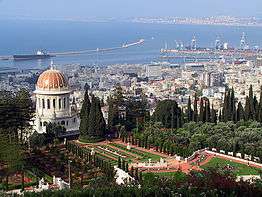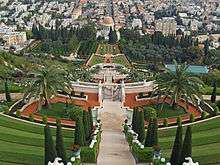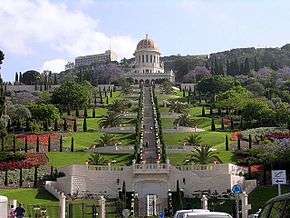Shrine of the Báb


The Shrine of the Báb is a structure in Haifa, Israel where the remains of the Báb, founder of the Bábí Faith and forerunner of Bahá'u'lláh in the Bahá'í Faith, have been buried; it is considered to be the second holiest place on Earth for Bahá'ís, after the Shrine of Bahá'u'lláh in Acre. Its precise location on Mount Carmel was designated by Bahá'u'lláh himself to his eldest son, `Abdu'l-Bahá, in 1891. `Abdu'l-Bahá planned the structure, which was designed and completed several years later by his grandson, Shoghi Effendi.
Crowning the design, as anticipated by `Abdu'l-Bahá, is a dome, which is set on an 18-windowed drum. That, in turn, is mounted on an octagon, a feature suggested by Shoghi Effendi. An arcade surrounds the stone edifice.
A restoration project of the exterior and interior of the shrine started in 2008 and was completed in April 2011.[1]
History


The remains of the Báb were buried on March 21, 1909 in a six-room mausoleum made of local stone. In a separate room, the remains of `Abdu'l-Bahá were buried in November 1921. In 1929 three rooms were added to the mausoleum, and in 1949 the first threshold stone of the superstructure was laid by Shoghi Effendi. The construction was completed over the mausoleum in 1953 and was entirely paid for by Bahá'ís around the world.[2]
The architect was William Sutherland Maxwell, a Canadian Bahá'í who was a Beaux-Arts architect and the father-in-law of Shoghi Effendi. Shoghi Effendi provided overall guidance, including in the use of Western and Eastern styles, but left the artistic details to Maxwell. Maxwell's design of the Rose Baveno granite colonnade, Oriental-style Chiampo stone arches, and golden dome is meant to harmonize Eastern and Western proportions and style. Maxwell died in 1952, and Shoghi Effendi named the Southern door of the Shrine after him. Some remaining aspects of the dome's structural engineering were designed by Professor H. Neumann of Haifa's Technion University.[2]
In 1952, Leroy Ioas, an American Bahá'í who had been closely associated with the construction of the Bahá'í House of Worship in Wilmette, Illinois helped Shoghi Effendi in the construction process. Ioas employed his administrative skills and practical mind to supervise the building of the drum and dome, a task done without the availability of sophisticated machinery. Shoghi Effendi called the door on the octagon after him.[2]
Because of the scarcity of building materials in the area after World War II, most of the stones for the Shrine of the Báb were carved in Italy with the assistance of Ugo Giachery and then shipped to Haifa. One of the doors of the Shrine was named after Giachery. The superstructure was said to be at the time the largest prefabricated building to move from Europe to any point in the world.[2]
On July 8, 2008, the Shrine of the Báb, along with several other Bahá'í holy sites in Haifa and the nearby city of Acre (Akko), were inscribed on the UNESCO World Heritage List.[3][4] The Bahá'í shrines "are the first sites connected with a relatively new religious tradition to be recognized by the World Heritage List."[5] The UNESCO World Heritage Committee considers the sites to be "of outstanding universal value [and]...inscribed for the testimony they provide to the Bahá’i’s strong tradition of pilgrimage and for their profound meaning for the faith."[6]
"We welcome the UNESCO recognition, which highlights the importance of the holy places of a religion that in 150 years has gone from a small group found only in the Middle East to a worldwide community with followers in virtually every country," said Albert Lincoln, secretary-general of the Baha'i International Community.
Design and composition
The dome is composed of 12,000 fish-scale tiles of 50 different shapes and sizes made in Portugal by employing an innovative process involving fire-glazing over gold leaf.[7] The cylinder drum rises 11 meters and rests on a circular steel-reinforced-concrete ring on the top of the octagon. The Shrine is also decorated with emerald green and scarlet mosaics on the balustrade above, a fire-gilded bronze symbol of the Greatest Name of the Bahá'í Faith at the four corners, and a multitude of intricate decorations and motifs.[2][8]
Interior
The Shrine is a place for quiet prayer and meditation where no ceremonies or religious services are held. A special prayer used by Bahá'ís when visiting the Shrine, known as the Tablet of Visitation, is hung on the wall in both the original Arabic and an English translation.[9]
Titles
Shoghi Effendi, in a message dated 19 August 1953, has described the Shrine in the following poetic way: "...Queen of Carmel enthroned on God's Mountain, crowned in glowing gold, robed in shimmering white, girdled in emerald green, enchanting every eye from air, sea, plain and hill."[10] He has also called the Shrine the Kúh-i-Núr (Mountain of Light), facing and overshadowed by the Daryá-yi-Núr (Ocean of Light, the Shrine of Bahá'u'lláh).[11]
Terraced gardens

Surrounded by terraced gardens, the Shrine is one of the most recognizable landmarks in Haifa and has attracted millions of visitors. The Shrine is enhanced by 19 garden terraces that stretch one kilometre from the base of Mount Carmel to its summit, and both the terraces and the Shrine are illuminated at night.[2] The Bahá'ís consider the Shrine of the Báb and the surrounding gardens to be a "gift to humanity."
Notes
- ↑ "Beauty of restored Shrine set to dazzle visitors and pilgrims". Bahá'í World News Service. 2011-04-12. Retrieved 2011-04-12.
- 1 2 3 4 5 6 "Golden anniversary of the Queen of Carmel". Bahá'í World News Service. 2003-10-12. Retrieved 2007-05-12.
- ↑ UNESCO World Heritage Centre (2008-07-08). "Three new sites inscribed on UNESCO's World Heritage List". Retrieved 2008-07-08.
- ↑ World Heritage Committee (2007-07-02). "Convention concerning the protection of the world cultural and natural heritage" (PDF). p. 34. Retrieved 2008-07-08.
- ↑ Israeli Baha'i sites recognized by UNESCO Haaretz.com
- ↑ UNESCO World Heritage Centre (2008-07-08). "Bahá'i Holy Places in Haifa and the Western Galilee". Retrieved 2008-07-08.
- ↑ "Golden tile from Baha'i shrine goes on display in museum". Bahá'í World News Service. 2007-03-20. Retrieved 2008-08-11.
- ↑ Giachery, Ugo (1973). Shoghi Effendi - Recollections. Oxford, UK: George Ronald. pp. 68–108. ISBN 0-85398-050-0.
- ↑ For pictures of the inner Shrines of the Báb and 'Abdu'l-Bahá, see The Bahá'í World, Vol. III, p. 22 and Vol. XIV, p. 124.
- ↑ Giachery, Ugo (1973). Shoghi Effendi - Recollections. Oxford, UK: George Ronald. p. 107. ISBN 0-85398-050-0.
- ↑ Khadem, Dhikru'llah (March 1976). "Bahá'u'lláh and His Most Holy Shrine". Bahá'í News (540): 15.
References
- Smith, Peter (1999). A Concise Encyclopedia of the Bahá'í Faith. Oxford, UK: Oneworld Publications. ISBN 1-85168-184-1.
Further reading
- Sharon, Mohse. (2008). Prophets and Mountains in: Lights of Irfan, Volume 9, pages 315-320, Wilmette, IL: Irfan Colloquia.
External links
| Wikimedia Commons has media related to Shrine of the Báb. |
- The Bahá'í Gardens - Official Website
- Bahá'í Pilgrimage - Shrine of the Báb
- More pictures of Shrine of the Báb
- Baha'i World News Service: Golden tile from Baha'i shrine goes on display in museum
- Photos - The Bahá'í Gardens in Haifa: the Shrine of the Bab Terraces & Gardens
- Haifa's Majestic Bahai Gardens - A UNESCO World Heritage Site
Coordinates: 32°48′52″N 34°59′14″E / 32.81444°N 34.98722°E

